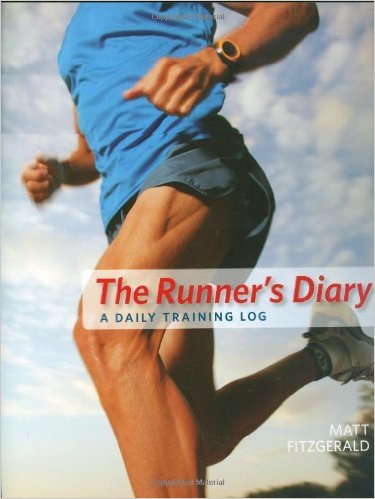关于作者Matt Fitzgerald更多资料见:
Matt Fitzgerald_运动营养学专家_Runner's World书籍作者-跑步作家-人物百科-跑步百科
//www.nduoke.com/renwubaike/matt-fitzgerald
Matt Fitzgerald出版的十多本畅销运动营养、跑步饮食书籍合集见:
Matt Fitzgerald(Runner's World运动营养学专家)书籍合集(附PDF电子书网盘下载地址)
//www.nduoke.com/running-books/matt-fitzgerald-books
《The Runner's Diary: A Daily Training Log》简介:
Whether they're training for a marathon or just trying to stay in shape, runners log hundreds of miles every year. "The Runner's Diary" gives them a place to keep track of them all. Inspired by VeloPress' best-selling training diaries for triathletes and cyclists, this comprehensive journal allows athletes to record all the information they need to stay on target with training goals and to better understand their performance. With ample space to note distance, pace, heart rate, and effort level, runners can review their entire season or refer back to earlier workouts. Room for tracking daily vital signs like resting heart rate, soreness, and quality of sleep and nutrition helps runners keep tabs on their overall health, while a race section with space for dates, distances, and times helps them chart their progress.
《The Runner's Diary: A Daily Training Log》评价:
From the Publisher
- "Throughout my career I have benefited from keeping a running diary yet I never had an orderly way to track everything, leaving me with a jumbled mess of tattered, lined paper in an exploding notebook.The Runner's Diaryis the perfect solution."-- Ryan Hall, 2008 Olympic marathoner, 2007 U.S. Half-Marathon champion, 2006 U.S. Cross Country champion
- "I've used a training log for my entire career, and I'm really impressed byThe Runner's Diary. It's organized in an easy-to-use format that is accessible to everyone from beginner to the seasoned runner."-- Mary Decker Slaney, world record holder and Olympian
- "The Runner's Diaryrecognizes that running is not just about the day-to-day itself, it's about using each day to work towards long term goals. The planning tools and weekly summary help athletes keep the big picture in mind."-- Shannon Rowbury, 2008 Olympic team member, 2008 USATF Indoor National Champion
- "I really liked having separate sections to track my weight, resting heart rate, and workout effort."-- Dathan Ritzenhein, 2005 and 2008 U.S. 12km Cross Country champion
About the Author
Matt Fitzgerald is a certified sports nutritionist and the author of numerous books on running, triathlon, nutrition, and weight loss. His most recent books areRacing Weight Cookbook, Racing Weight Quick Start Guide, RUN: The Mind-Body Method of Running by Feel, Racing Weight, Brain Training for Runners,andThe Runner's Diary. Matt is a regular contributor toMen's Fitness, Men's Health, Outside, Runner's World, Bicycling, Running Times, Women's Running,and other sports and fitness publications. Fitzgerald is a featured coach on TrainingPeaks, Pear Sports, and Active.com. He is a certified sports nutritionist (CISSN) licensed by the International Society of Sports Nutrition. He lives and trains near San Francisco, California.
《The Runner's Diary: A Daily Training Log》读者评价:
I've used this for 2009, and I bought another to use for 2010. I like it (obviously). It has enough space in each daily field to enter notes from each run, without asking for a lot of info that I don't collect. It tries to double as a food log, with each day ending with a "nutrition" section that has a space under each of these headings: veggie, fruit, grain, meat/fish, nut/seed/bean, water, sweet, fried. Matt wants you to enumerate youor servings of each. Since I keep a food log separately, I don't use this part -- I just write in the workout calories burned as estimated by my GPS and my HR monitor (which always wildly disagree). Each week uses 4 pages, 2 days/pg, with the last half page for a weekly summary, which has a year-to-date column for tracking your total miles and training hours. Every 4 weeks it has a monthly planning calendar, a 2-pg spread that looks like a wall calendar; I don't use it, but use the pgs to staple race bibs or workout tips from the web or magazines.
I started keeping running calendars before there were running calendars. I used and appreciated Marty Jerome's Complete Runner's Day by Day Log for 10 years straight, but had to make spaces for all the extras I wanted to put in; on long runs there was barely enough room to split 8, much less 16 miles into minutes per mile.
The Runner's Diary takes care of this problem, with LOTS of room and spaces for time, distance, thoughts on how one felt about their run, what they ate and drank that day and the like. It is easy to just fill in the info and saves me from writing some of the extra category titles each day. A much more complete picture emerges through this format than others. I didn't realize how many sweets I ate every day, or how many glasses of water I drank.
Unlike other commentators, I enjoy seeing the cumulative miles as the weeks go by and I don't mind turning the pages to fill in the week (I think it takes 4 pages for each week with a section for the weekly summary which I really like).
The Lack of Set Dates:
When it comes down to it, my phone, my watch, my computer, they all tell me the exact day and time.
I almost avoided this calendar (or non-calendar) because of the lack of SET dates. In fact, I bought a copy of this product a few years back but defaulted to the Marty Jerome Calendar for this very reason. But really, The Runner's Diary is a superior format. When I first started keeping track of my daily run back in the 70's I used to write information on my wall calendar (REALLY hard to fit in everything there) and last year I experimented with on-line calendaring. For me it is easier to reflect with a pen than a keyboard and over the years I have added more details each time I recorded a run. When I look back, the more info I wrote, the more I could see patterns of what worked, what helped me recover from injuries and what was fun for me.
Summing Up:
I will check in on this review occasionally to see how I feel as the year progresses, but so far so good. Glad I'm not doing it on a computer and glad to have the extra room that I have always wanted; I guess that is the difference between a log (Jerome) and a diary (Fitzgerald).
One last thing, The Runner's Diary doesn't use the glossy paper that the Jerome calendar does. It is much easier to write at length, and my pen doesn't clog up. Its just a little thing, but it does count...although it was kinda fun watching the Jerome clan grow up in those funky black and white pics over the years; God bless them and I hope they are still out there running.
Diaries rarely come with set dates, do they?
This running diary is a lot easier to write in and the potential is there for one to enter a lot more information more easily.
Still, my fastest mile ever is recorded in an old Sierra Club calendar from the mid 80's.
My mom bought me this for Christmas after seeing it on my Amazon wish list.
Pros:
-Several of the features are new to me and very useful, such as the system Fitzgerald uses to measure the intensity of your workout.
-There is a good introdution, guide for use, and clear explanations of the diary's workings by Fitzgerald in the beginning.
-Appendicies contain useful workout information, with many types of runs, many of which I was unfamilliar with and have sucessfully incorporated into my training.
-I like that it is portable, and I take it to the gym with me (I run on treadmills for the most part in the winter, lots of snow here in Spokane, WA,) and record my data right after I run so I don't forget any details.
-I also love that there's a monthly calender that allows you to plan your workouts out a month ahead. He also includes a sample month and breakdown (one week, by weekday,) of his own training schedule and data. Lots of great info here.
-There are little boxes at the bottom of each weekday for the different foodgroups, (veggies, meat, etc.) so you can record the number of servings you ate that day. I already use another, more detailed system to keep a close watch on my diet, but this might me a useful nutritional tool for some.
-Weekly summery allows you to keep track of weekly and yearly distance and time run.
-There is no gender-specific information. Some runners would think this was a con; as a female runner, I get tired of seeing "running for Women" books. The basic information applies to everyone.
更多runner's world 杂志与书籍见://www.nduoke.com/running-books/runners-world
更多跑步书籍见://www.nduoke.com/running-books
跑步书籍下载见://www.nduoke.com/shujixiazai
跑步书籍百科见://www.nduoke.com/shujibaike




